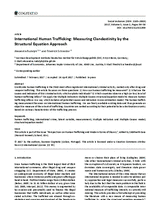International human trafficking: measuring clandestinity by the structural equation approach
Rudolph, Alexandra / Friedrich SchneiderExterne Publikationen (2017)
in: Social Inclusion (Special Issue) 5 (2), 39–58
Worldwide human trafficking (HT) is the third most often registered international criminal activity, ranked only after drug and weapon trafficking. This paper focusses on three questions: 1) How can human trafficking be measured? 2) What are the causes of this criminal activity of exploiting individuals? and 3) Which countries observe a high (low) level of human trafficking inflows? We apply the Multiple Indicators Multiple Causes (MIMIC) structural equation model to measure HT inflows and to include all potential causes and indicators in one model. The HT measure focuses on international human trafficking for 142 countries in the 2000-2010 period. We use existing freely available data and thus generate an objective measure of the extent of trafficking in destination countries. We find the index to be relevant compared to other measures of HT such as the Tier rank of the US State Department. Countries are ranked according to their potential of being a destination country based on characteristics of the trafficking process. In general, HT is observed in more prosperous countries with traditions of immigration. Even though the index shows a divers picture of human trafficking inflows into a divers set of countries including European, Northern American as well as African countries.

